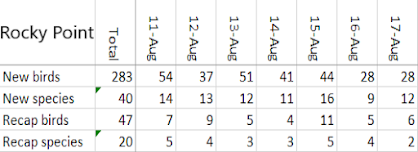Week 5 is typically the middle of our "August doldrums", marked by sunny, hot, and slow days at the stations. While these are great for training, they can be a little tiresome as we wait for migration to pick up. Luckily this year continues to produce surprises, and both stations shook off the lull with above-average weeks and some interesting birds. Several of our newer volunteers even got to band their first bird!
Pedder Bay managed to stay quite consistent this week, with between 20 and 28 new birds per day, ending up with a total of 177 new bands (average 164 for week 5). With a season total of 1032 birds banded, we are well above the average of 959 for this point in the season! Our top capture this week was White-crowned Sparrow, unsurprisingly, with 34 individuals banded, followed by Swainson's Thrush (20) and Pacific-slope Flycatcher (17). Our highlights of the week at Pedder Bay were our second Northern Waterthrush of the season there, and breaking the record for most Chipping Sparrows banded in a season (old record 35, current total 38). A few other species are on track for great years, but we'll have to wait a few more weeks to see if they cross the threshold! One other nice bird in the nets was an after-hatch-year male Townsend's Warbler, a plumage we rarely have the opportunity to see and study in the hand.
 |
AHY Male Townsend's Warbler (Aiva Noringseth)
|
Rocky Point had its typical peaks and lulls, with 31-49 new birds per day, totalling 265 for the week (average 248). With a season total of 1269, we are still sitting in second all-time for this point in the season, only trailing 2005 which was our highest-ever season! Flycatchers dominated at Rocky this week, with Pacific-slope taking top spot at 49 individuals banded, and Willow in third with 26. White-crowned Sparrows took second place with 32. Highlights in the nets included our second Alder Flycatcher of the season (fourth all-time for Rocky Point, and fifth for RPBO), our first Barred Owl of the season, and our first and second Northern Waterthrushes of the season for that station. We also managed to break the record for most Brown-headed Cowbirds banded in a season, with our 27th individual (previous record 26). A "one that got away" tale to add to the collection happened on the 23rd when the crew at Rocky Point captured a Lazuli Bunting - unfortunately it escaped before it could be processed or photographed...better luck next time! The blue in the title is in brackets as this hatch-year bird was actually quite brown - only the adult males get any significant amount of blue (lazuli) in their plumage.
 |
Alder Flycatcher (David Bell)
|
 |
| Northern Waterthrush (Siobhan Darlington) |
|
 |
Barred Owl (David Bell)
|
 |
The record-breaking Brown-headed Cowbird (David Bell)
|
Warbler and shorebird migration is in full swing, and some nice mixed flocks were around throughout the week at both stations, although the shorebirds were mostly out at Rocky Point. New arrivals for the season at Pedder Bay included Green-winged Teal, Wilson's Snipe, and Short-billed Dowitcher, while Rocky Point added Northern Pintail, Northern Shoveler, Sora, Northern Pygmy-Owl, and Bank Swallow.
 |
A sunny day at Rocky Point (Siobhan Darlington)
|
Other wildlife this week included a few Black Saddlebags dragonflies and a neat sea slug out at Rocky Point, in addition to the usual Humpbacks, deer, squirrels, raccoons, etc., and the omnipresent chorus of sea lions. An interesting observation (at least for me) was one of the female Black-tailed Deer at Pedder Bay seemingly teaching her fawns 'predator avoidance tactics' as she ran after them and tried pouncing on them, while they sprinted as fast as they could away over the hills. Luckily they stopped this behaviour before getting close to the nets! Additionally, the blackberries are approaching peak ripeness, to the delight of us and the birds alike.
 |
Ripe blackberries! (Julian Powers)
|
From this point forward, the season typically picks up as more and more migrants depart the northlands and head south for the winter. We're still looking to fill a good number of shifts in the next few weeks, so please take a look at the schedule and see if there are any empty slots that coincide with your free time. We and the birds would appreciate it!
 |
Daily totals for week 5
|
 |
Season totals (click to enlarge)
|
As an aside, does anyone else think these birds should have been named differently? Lazuli Bunting (bottom left) is named after lapis lazuli (top left), when it is more turquoise in colour (bottom right). Indigo Bunting (top right) is pretty much the colour of lapis lazuli. Petition to rename Indigo Bunting to Lazuli Bunting and change Lazuli to Turquoise Bunting? (images from Google search, used under fair use).













































